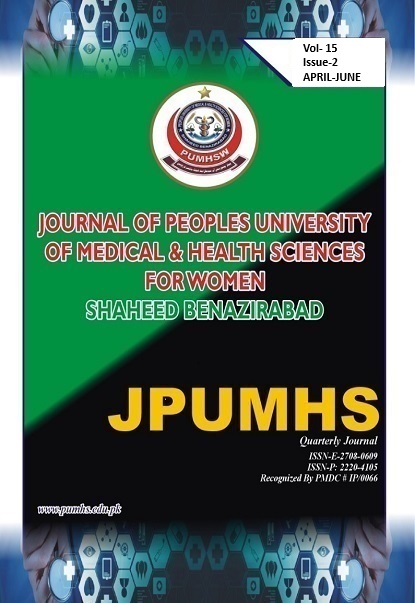FREQUENCY AND CLINICAL SPECTRUM OF DIABETIC DERMOPATHY IN A TERTIARY CARE HOSPITAL: A DESCRIPTIVE STUDY.
J Peop Univ Med Health Sci. 2025:15(2),168-174. http://doi.org/10.46536/jpumhs/2025/15.02.637
Keywords:
Diabetic dermopathy, diabetes mellitus, cutaneous manifestations, frequency, PakistanAbstract
BACKGROUND: The most frequent cutaneous manifestation of diabetes mellitus is diabetic dermopathy, usually found as asymptomatic brown macules on the shins. Though it is frequent, local information on its frequency and clinical spectrum in Pakistan is scarce. OBJECTIVE: To find the frequency and outline the clinical spectrum of diabetic dermopathy among patients with diabetes mellitus in a tertiary care hospital. METHODS: This was a descriptive cross-sectional study at the Dermatology and Medical Departments, Peoples Medical College Hospital (PMCH), Nawabshah, spanning six months. 385 consecutive diabetes mellitus patients were enrolled using non-probability consecutive sampling after informed consent. In-depth history, dermatological examination, and documentation of diabetic dermopathy (lesion features, number, location, symptoms) were obtained. RESULTS: In 385 patients (mean age 54.6 ± 10.8 years; 56% women), the prevalence of diabetic dermopathy was 34.8% (n=134). Most lesions were brownish macules on the anterior shins that were asymptomatic (89%), with 65% being bilateral. The number of lesions per patient varied from 2 to 12 (mean 5.1 ± 2.3). The incidence of dermopathy was more in the poorly controlled glycemic group (HbA1c >8%; p<0.05). There was no gender predilection. Forearms (7%) and thighs (4%) were other affected areas. 12% of dermopathy cases presented with pruritus. CONCLUSION: Diabetic dermopathy occurred in more than one-third of diabetes mellitus patients in our tertiary healthcare center, with the most prevalent presentation being asymptomatic brown macules on the shins. Routine dermatologic checks in diabetic patients help in the early recognition of dermopathy as a clinical marker of microangiopathic complications and disturbed glycemic control.
Downloads
Downloads
Published
How to Cite
Issue
Section
License

This work is licensed under a Creative Commons Attribution-NoDerivatives 4.0 International License.




